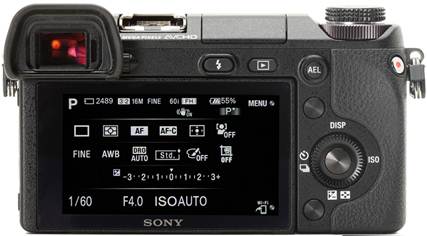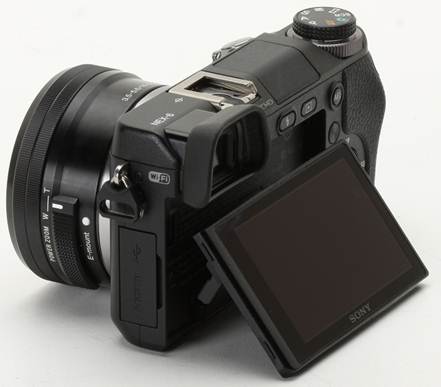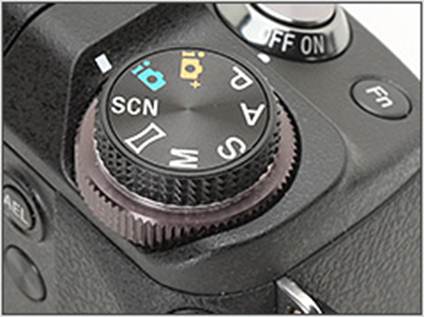Using the NEX-6
Anyone who has used a previous NEX model will be able to
receive and use the NEX-6 with a bit difficulty. Its user interface is not for
everyone, although the improvements that Sony has made over the years have
caused it to be a bit easier to use than the original NEXs. In previous NEX
cameras, for example, you have to delve into the menu system to tweak the
exposure mode. While it may seem negligible, the NEX-6’s new mechanical mode
dial makes operating the camera less monotonous, if you are the type of person
who occasionally switches between exposure modes.

The screens that
are available in live view mode show capturing data in a lot of different
formats, as well as an electronic level. The screens vary a little when watched
on the EVF.
The 'Quick Navi' black screen (described below) is designed
for use when capturing with the EVF.
Electronic viewfinder and LCD screen
The EVF (electronic viewfinder)of the NEX-6 is one of the
best on the market, with impressive resolution (approximately 30% higher
resolution in both dimensions than most of the rivals) accurate color; and
there is no rainbow effect that you will probably find in some other EVFs. The
EVF was overall bright enough for capturing outdoors (with eyecup attached),
and as well as the objects could be easily visible in low light conditions.
Like all of the EVFs, some stair-stepping could be seen along shallow diagonal
lines, and sometimes we saw some ripples in the high-frequency scene elements
(some fabrics, distant roof tiles, etc.).

The most significant
difference in terms of physics between the NEX-6 and its five predecessors is
the inclusion in the NEX-6 of an electronic viewfinder (EVF). A 2.3 million dot
OLED screen (1,024 x 768 pixels) with a 1.09x magnification which is certainly
very nice to look at.
The Fujifilm X-E1 features the same OLED display unit like
the NEX-6 but provides a lower magnification view and the distance to reduce
eye strain is greater. This has the effect of making the X-E1’s EVF slightly
less 'immersive' than the NEX, but it ensures that you can see all four corners
of the landscape freely without needing to move your eyes too much. With the
NEX-6 we have realized that the direct view image looks a bit too big to have a
really clear view of the overall scene without casting a glance around. This is
a bigger problem when wearing glasses, but removing the NEX-6’s eyecup is
likely to help solve this.
An eye sensor to the right side of the screen automatically
switches between the EVF and the rear LCD screen. The eyecup blocks light well
enough to prevent eye sensor from being accidentally slipped (unlike the X-E1,
which can operate inconsistently in the bright rear or side-light. You are also
able to find here a diopter adjustment knob which has a scope of -4m to +1 m

The 3-inch LCD
screen of the NEX-6 is likely to rotate upwards by 90 degrees, and downwards by
45 degrees. Articulating LCD screens let you shoot over the heads of people in
front of you; this is an advantage.
And like the NEX-7, the position of the NEX-6’s viewfinder
sets limits on the movement of the rear LCD screen. You can rotate this 3-inch,
921k dot screen upwards by 90 degrees and downwards by nearly 45 degrees, but
it will not pop up above the camera in a direction facing the front like the
same spec’s unit on the NEX-5R. Ability to display LCD screen outdoor is rather
good, but not stunning. Because the NEX-6 lacks the automatic brightness
adjustment, I frequently found myself increasing the brightness manually when
shooting under bright sunlight. There is a super-bright screen mode; the 'sunny
weather' gives higher saturation but we have realized that this is a bit too
much, in all except for the bright light.
A few more things about the rear LCD screen that might cause
annoyance to some people is derived from its native 16:9 aspect ratio, which
provides a large amount of redundant black on the right side of the images that
you have just captured. Still in terms of the rear screen, we are disappointed
when Sony has chosen to give up the touchscreen ability of the previous NEX
models. In the world of Sony you may get an integrated EVF (NEX-6 and NEX-7) or
a touchscreen (NEX-5R and NEX-5N), but obviously you cannot have both.
Mode dial

Aside from the
standard PASM modes, the mode dial of the NEX-6 provides both Superior and
Intelligent Auto, Scene and Sweep Panorama modes. Directly below it is the
greater diameter control dial.
In the first version of the NEX lineup, the NEX-6 has the
change of an external eight-position mode dial. As you can see in the picture
above, it is placed directly on top of another dial - this is a control dial to
adjust the exposure parameters. The exposure mode dial of the NEX-6 is only
slightly smaller in diameter (much tighter) than the mode dial found on the
Sony STL-A57 and is solid enough to prevent inadvertent operation while holding
the camera.